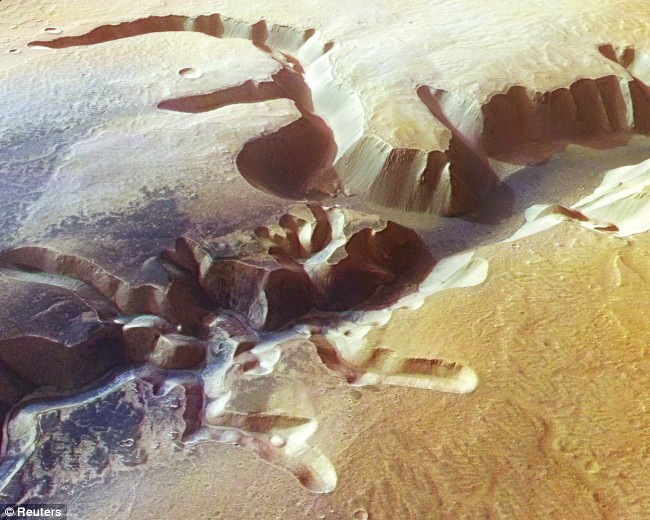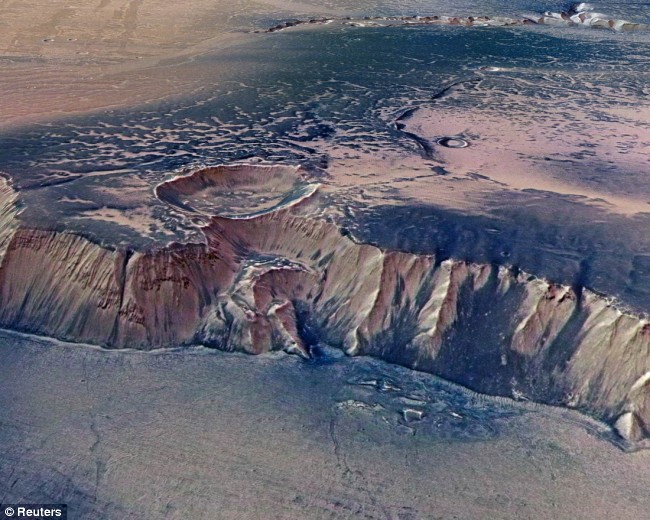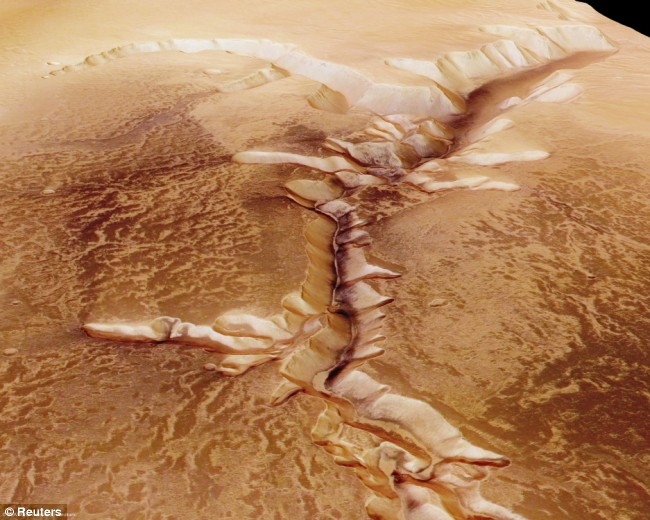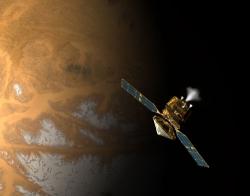NASA
is ready to add one more spacecraft to the constellation of orbiters
and landers exploring the red planet.
The
Mars Reconnaissance Orbiter (MRO) is ready to put the brakes on,
slowing itself down for insertion into orbit around the planet.
Arrival time is March 10 as MRO fires its main thrusters to slow
itself enough to be captured by Mars’ gravity.
Launched
last August, the instrument-loaded spacecraft has journeyed across the
vacuum void and will soon begin its unprecedented surveying of Mars.
MRO
has been performing extremely well during its cruise to the red
planet, said Doug McCuistion, NASA Mars Exploration Program Director
at NASA Headquarters in Washington, D.C.
Given
earlier Mars missions that have failed to reach the planet, McCuistion
cautioned: “Mars is hard. Mars can be unpredictable.” Getting into
Mars orbit is not an easy task, he said during an MRO press briefing
held today at NASA Headquarters.
“We’re
95 percent there,” said James Graf, MRO Project Manager at the Jet
Propulsion Laboratory (JPL) in Pasadena, California. JPL is managing
the $720 million mission for the NASA Science Mission Directorate.
Crucial
maneuver
To
slip into Mars orbit, MRO will fire its thrusters for about 27
minutes—decreasing the velocity of the spacecraft by 18 percent.
That maneuver is crucial; otherwise the probe will sail right past
Mars.
The
process of slowing down MRO at Mars is going to be a nail biter for
ground controllers.
“We’re
doing a lot of first events,” Graf explained. First, the propellant
system to fire MRO’s thrusters must be pressurized. In addition,
there are software patches onboard the spacecraft that have not been
used before, he said.
Once
MRO is firing its thrusters, it will go behind Mars—out of contact
with mission controllers. “We’ll be out of touch for the next 30
minutes…so we will not see the end of the burn itself,” Graff
said.
Start
of the suspenseful Mars Orbit Insertion (MOI) thruster firing is 1:25
p.m. Pacific Standard Time, with MRO coming out from behind the planet
at 2:16 p.m. PST.
Deep
dipping
Given
a successful MOI, the spacecraft will spend half a year dipping in and
out of Mars’ atmosphere in a process tagged as
“aerobraking”—adjusting its initial 35-hour elongated orbit into
a nearly circular, two-hour loop around Mars.
MRO’s
aerobraking is to take place from March into October and calls for
hundreds of precision-controlled dips into the upper atmosphere of
Mars. Those dips have to be deep enough to slow the spacecraft by
atmospheric drag, but not so deep that the orbiter becomes overheated.
The
primary science-gathering phase of MRO is slated to start in November
2006 and last for over two years.
“MRO
opens a new chapter in the history of Mars exploration,” said Bob
Berry, Director of Space Exploration Systems at Lockheed Martin Space
Systems Company near Denver, Colorado. The aerospace firm designed,
built and operates MRO. The spacecraft carries six instruments and
features a set of solar arrays that stretch tip-to-tip some 46 feet
(14 meters), he said.
Berry
said that MRO carries enough propellant and energy supply to last more
than 10 years.
Over
and under observations
MRO
totes powerful instruments that can investigate every level of Mars:
From underground layers to the top of the planet’s atmosphere.
For
one, the Mars-bound spacecraft is hauling the most powerful telescopic
camera ever sent outward to scan another planet. That gear can spot
rocks the size of a small desk.
MRO
will chart water-related deposits in areas as small as a baseball
infield. The Italian space agency supplied the mission with a radar
designed to probe for buried ice and water.
Also,
a weather camera will monitor the entire planet daily, while an
infrared sounder is assigned the duty to gauge atmospheric
temperatures and the movement of water vapor.
JPL’s
Graf said that MRO will return more data than all previous Mars
missions combined.
Swimming
in the data stream
Thanks
to the huge amount of data streaming from MRO, scientists can expect a
real intellectual leap forward in better understanding the red planet,
said Michael Meyer, NASA Mars Lead Scientist at NASA Headquarters.
Along
with revealing Mars as never before, Meyer said MRO will guide future
mission decisions too.
MRO’s
powerful sensors can scope out the landing spot near the northern
polar ice cap where NASA’s Phoenix lander is slated to touch down in
2008, as well as the exploration zone in which the space agency’s
next rover—the Mars Science Laboratory—will head for after its
launch in 2009.
Even
those “little rovers that just won’t quit”—NASA’s Spirit and
Opportunity robots—can be seen by MRO, said NASA’s McCuistion. MRO
can also provide, he added, useful data for some of the early
decision-making as to where future human explorers can safely land on
Mars.
Moving
Day For Mars Reconnaissance Orbiter
Hello
Mars, Meet 'MR. O': The Mars Reconnaissance Orbiter



